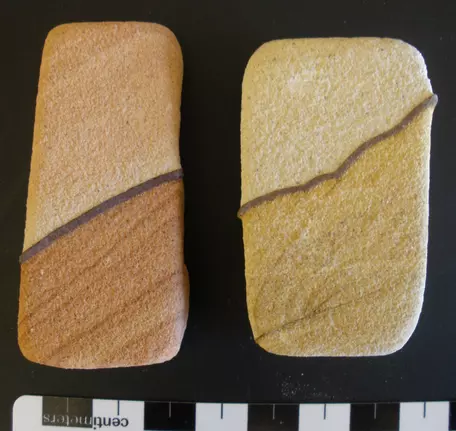Initial Publication Date: October 23, 2012
Cooking Rocks: Diagenesis
Homework 1- How Mars rocks change and evolve
Dr. Marjorie Chan PhD, University of Utah Department of Geology and Geophysics
(Note that the In-Class Activity for this module is based on completion of this homework)
Purpose
Understand how iron oxide minerals depend on water. Hematite occurs at Meridiani Planum, Mars. "Blueberries" are believed to be diagenetic (secondary origin due to fluid movement through the sediment). Hematite is a stable mineral form that can have other original precursor minerals. To understand more about mineral stability we undertake a small experiment here.
Note: Diagenesis means secondary origin (changes after deposition).
Materials Needed
- rock sample (your own pet rock picturestone)
- oven access
- digital camera
- time: this assignment may take up to a few hours
Activity/Assignment
- Get your piece of "Kanab Picturestone" rock. This is an ancient (Triassic) porous sandstone that has liesegang bands (iron-oxide mineral bands), a record of past fluids that moved through the rock during its burial history.
- Decide on an experiment to test how goethite (FeOOH) can transform to hematite (Fe2O3). In general the change can occur at temperatures of about 400 degrees F in a normal oven for about an hour or more. Experiment with some different conditions (e.g., you may want to vary the time, and/or temperature). Leave the rock in the oven to cool before attempting to remove it!
- Be sure to use some aluminum foil or something underneath your sample so sand grains don't get all over your oven, and/or it can protect your container if you are using one. If some of you have access to a chemistry hotplate, you could try it on that as well. Observe safety and caution at all steps (e.g., use safety goggles, and use insulated gloves/potholders). If your rock contains water, it is possible something could pop so it is advisable to have some aluminum foil around it loosely, and let it cool before trying to examine it. Be sure to keep track of your sample in the oven so you do not forget it and leave it unattended.
What you turn in
- A short, typed 1 to 2-page report with your name, and titled sections that have: A. Purpose, B. Hypothesis, C. Methods, D. Analysis, Results, and E. Conclusion.
- Your report should include a before and after picture of your sample in the same position and location with a consistent scale (show a ruler or similar measuring tool to indicate scale when taking photos). This can go on a separate page if you wish.
- Label your pictures and include appropriate explanatory photo captions.
- Make sure you document the actual conditions (temperature of oven, duration of time sample spent in oven, etc.) of your experiment and any other unusual circumstances.
Additional or Optional Ideas to Pursue
- Are the mineralogic changes detectable analytically besides by just the coloration visible to the eye? To better understand mineralogic changes, students can do XRD or Vnir spectroscopy to identify the minerals before and after.
- Would adding water into/onto the "after" sample change the mineralogy? Why or why not?
- Which of these minerals are present on Mars? Why would one be more common than another?
- How long would it take to get hematite on Mars, did it form quickly or slowly? See ref. Elwood Madden, M.E. et al. 2009, How long was Meridiani Planum wet? Applying a jarosite stopwatch to determine the duration of aqueous diagenesis: Geology v. 37, p. 6350638. (geology.gsapubs.org/content/37/7/635.full.pdf) Dissolution rates of the mineral jarosite suggest that hematite would have formed quickly.
- How would coarse crystalline hematite form on Mars? See ref. Madden, A. S., et al. 2010, Low-temperature mechanism for formation of coarse crystalline hematite through nanoparticle aggregation: EPSL v. 298, p 377-384. http://www.sciencedirect.com/science/article/pii/S0012821X10005248 Either freezing or cryodessication of nanoparticle hematite platelets could lead to the formation of coarse crystalline hematite.
- Would temperature or salinity affect the hematite formation rates? See ref. Elwood Madden, M.E. et al. 2012, Jarosite dissolution rates and nanoscale mineralogy: Geochemica et Cosmochimica Acta 91 p. 306 - 321. Jarosite dissolution rates are dependent on both temperature and the pH of the solution, which in term affects reaction products/mineralogies.


![[creative commons]](/images/creativecommons_16.png)